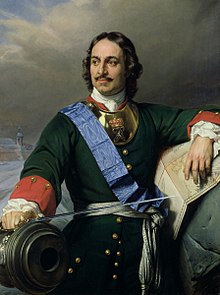User:LittleRoughRhinestone/russianhistoryassignment: Difference between revisions
No edit summary |
|||
| Line 3: | Line 3: | ||
'''Government reform under Peter I''' refers to modifications made to the state apparatus of [[Imperial Russia|Russia]] during the rule of [[Peter I of Russia|Peter I]]. |
'''Government reform under Peter I''' refers to modifications made to the state apparatus of [[Imperial Russia|Russia]] during the rule of [[Peter I of Russia|Peter I]]. |
||
Peter ascended to the throne in [[1682]]; he ruled jointly with his half-brother [[Ivan V]] until his death in [[1696]]. After this, Peter implemented a series of sweeping reforms aimed at modernizing Russia, modeled on [[The Enlightenment|Enlightenment]] ideals and influenced by advisers from Western Europe. At first, these reforms were intended to |
Peter ascended to the throne in [[1682]]; he ruled jointly with his half-brother [[Ivan V]] until his death in [[1696]]. After this, Peter implemented a series of sweeping reforms aimed at modernizing Russia, modeled on [[The Enlightenment|Enlightenment]] ideals and influenced by advisers from Western Europe. At first, these reforms were intended to support the [[Great Northern War]]; later reforms were more systematic and would significantly change the internal construction and administration of the state. |
||
==Background== |
==Background== |
||
Revision as of 21:18, 5 December 2010

Government reform under Peter I refers to modifications made to the state apparatus of Russia during the rule of Peter I.
Peter ascended to the throne in 1682; he ruled jointly with his half-brother Ivan V until his death in 1696. After this, Peter implemented a series of sweeping reforms aimed at modernizing Russia, modeled on Enlightenment ideals and influenced by advisers from Western Europe. At first, these reforms were intended to support the Great Northern War; later reforms were more systematic and would significantly change the internal construction and administration of the state.
Background
The majority of Peter's reign was dominated by the Great Northern War (1700-1721), during which Russia, along with a host of allies, seized control of the Baltic Sea from Sweden and gained considerable influence in Central and Eastern Europe. The war, one of history's costliest at the time, consumed significant financial and economic resources, and the administrative system Peter had inherited from his predecessors was inefficient at gathering and managing resources for the war.
During his Grand Embassy (Великое посольство), Peter conducted negotiations with a number of European powers to strengthen his position against Sweden and the Ottoman Empire. During this time, he was exposed to the developed nations of Western Europe and became intrigued with the prospect of turning Russia into an industrial economy. Despite Russia's vast size and considerable natural resources, economic performance was hampered by a number of factors, including corruption, inefficient allocation of agricultural resources, and lack of access to warm-water ports. Peter believed that reform would not only strengthen his hold on power, but increase the efficiency of the government, and thus better the lot of his people.
Like most of Russia's legal system at the time, Peter's reforms were codified and articulated in a series of royal decrees, issued chiefly between 1700 and 1721.
Provincial Reform
Prior to Peter's rule, Russia's administrative system was antiquated compared to Western Europe. The state was divided into districts, which mostly consisted of large cities and their immediate surrounding areas; this system divided the population unevenly and was extremely clumsy to manage. Beginning in 1708, Peter abolished these old national subdivisions and established in its place eight provinces (Областий, oblastiy), each with a royal governor. Another decree in 1713 established a Landrat (Ландрат, from the German word for "national council") in each province, staffed by civil servants.
Table of Ranks
Industry and Trade
Nobility and Peasantry
The Church
Compared to his predecessors, Peter's rule was marked by a larger degree of religious freedom. Non-Orthodox Christians and Muslims were permitted to practice and proselytize their faith, provided they paid an extra tax and not challenge the supremacy of the Orthodox Church.
